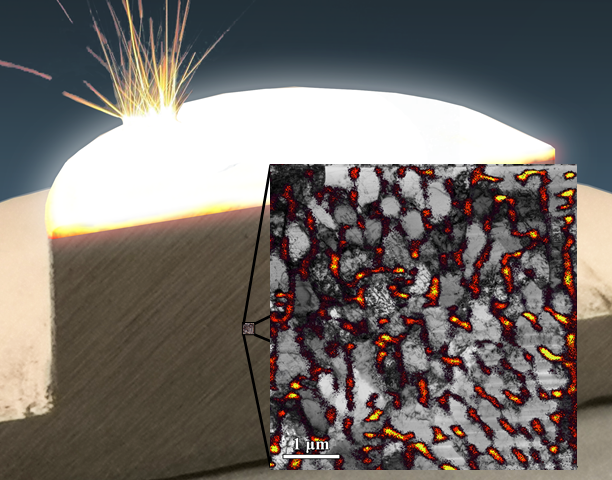Laser additive manufacturing involves 3D printing of parts, building them layer-by-layer by melting and resolidifying metal powders. This technique has come as a renaissance for researchers who learn how to engineer exclusive structural materials.
 A multimodal investigation of additively manufactured 316L stainless steel revealing a heterogeneous—and correlative—distribution of crystal defects in the bright-field transmission electron micrograph (grey-scale) and alloying elements in the superimposed x-ray fluorescence map (colored). Image Credit: Dr. W. Streit Cunningham and Prof. Jason Trelewicz/ Stony Brook University
A multimodal investigation of additively manufactured 316L stainless steel revealing a heterogeneous—and correlative—distribution of crystal defects in the bright-field transmission electron micrograph (grey-scale) and alloying elements in the superimposed x-ray fluorescence map (colored). Image Credit: Dr. W. Streit Cunningham and Prof. Jason Trelewicz/ Stony Brook University
Researchers from Stony Brook University have performed a new study that throws light on the link between the corrosion behavior and fundamental materials structure in laser additively manufactured 316L stainless steel. This steel is a corrosion-resistant metal extensively used in Naval applications.
The researchers used multimodal synchrotron X-ray methods to unravel new links between printing parameters and the material’s defect state. Thus, the researchers could map pathways for designing a much better corrosion-resistant printed alloy.
The results of the study were published in the November issue of Additive Manufacturing and could pave the way for future production of a highly corrosion-resistant stainless steel by designing its defects at the nanoscale.
The study also showed that multimodal synchrotron methods are becoming vital tools in forging correlations between the printing process, fundamental structure of the material, and its achieved performance.
The major focus of our study was to understand the corrosion behavior of laser additively manufactured 316L stainless steel in the context of microstructural defects that form due to the rapid solidification rates inherent to this 3D printing process.
Jason Trelewicz, PhD, Study Corresponding Author and Associate Professor of Materials Science and Engineering, College of Engineering and Applied Sciences and Institute for Advanced Computational Science, Stony Brook University
“We show that while uniform surface corrosion of the printed 316L is similar to a traditional 316L alloy, the printed material exhibits an increased susceptibility to pitting, particularly in the samples with the greatest defect density uncovered from our synchrotron measurements,” added Trelewicz.
The research group included scientists and students in Professor Trelewicz’s team, the Engineered Microstructures, and Radiation Effects Laboratory, joining hands with collaborators at Brookhaven National Laboratory, who executed the synchrotron X-ray experiments at Brookhaven’s National Synchrotron Light Source II (NSLS-II).
Collaborator Professor Guha Manogharan printed the 316L samples at the Pennsylvania State University. The researchers conducted correlative electron microscopy at the Center for Functional Nanomaterials (CFN) at Brookhaven while the corrosion measurements were carried out at Stony Brook University.
Apart from the development of innovative additively manufactured materials, Trelewicz notes that the results emphasize the possible vital role of correlative synchrotron X-ray and electron microscopy measurements in painting a comprehensive picture of volume-averaged microstructural trends in materials created through laser additive manufacturing.
The study was financially supported by the Office of Naval Research under contracts N00014-18-1-2614 and N00014-20-1-2293. For the experiments, beamlines 28-ID-1 (PDF), 28-ID-2 (XPD) and 3-ID (HXN) at NSLS-II, as well as resources in the Electron Microscopy Facility at the CFN, were used. The CFN and NSLS-II are both Department of Energy Office of Science User Facilities.
Journal Reference:
Sprouster, D. J., et al. (2021) Dislocation microstructure and its influence on corrosion behavior in laser additively manufactured 316L stainless steel. Additive Manufacturing. doi.org/10.1016/j.addma.2021.102263.